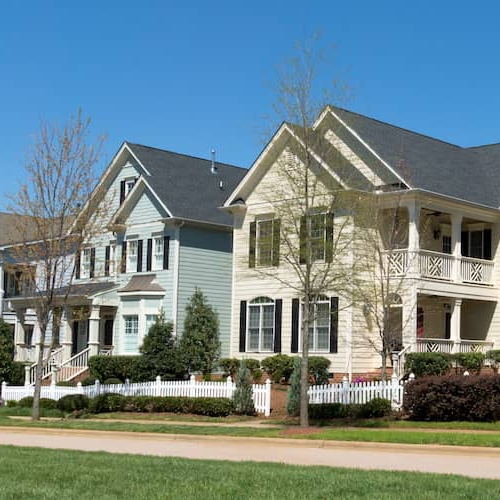USDA vs. FHA Loans: Which is better for you?
Mar 12, 2024
•7-minute read

*As of July 6, 2020, Rocket Mortgage® is no longer accepting USDA loan applications.
Home buyers with low or moderate incomes may gravitate toward mortgages with more lenient borrowing requirements, especially when it comes to down payments and mortgage insurance. This is why USDA and FHA loans can be so appealing to borrowers.
How do the two types of mortgage loans differ, though? This article will guide you through the differences between each loan’s eligibility requirements, as well as their processes.
USDA and FHA home loans: The basics
USDA and FHA loans are government loans backed by the U.S. Department of Agriculture (USDA) and the Federal Housing Administration (FHA), respectively. These government agencies don't actually give you a loan directly – they protect your lender against loss if you default on your loan.
As non-conforming loans, USDA and FHA loans don’t have to adhere to housing standards set by government-sponsored enterprises like Fannie Mae and Freddie Mac. However, like other types of loans, government-backed loans have their own qualifying criteria.
Differences between FHA and USDA loans
USDA and FHA loans are run by two different government agencies, which means they have different application, underwriting, appraisal, lending amount, mortgage insurance and interest rate requirements.
Application process and underwriting
Regardless of which mortgage product you choose, the first step to homeownership is applying for preapproval, and that's true of both USDA and FHA loans. The preapproval shows home sellers you're serious about buying and assures them you may be approved for the mortgage.
You may also have the option of getting a prequalification, where the lender bases the decision on information that you provide. With a preapproval, the lender goes one step further by running a report on your credit history and requiring documentation such as tax documents and pay stubs to get an accurate picture of how much home you can buy.
Getting a USDA or FHA preapproval or prequalification will kick off the mortgage underwriting process so you can shop for a home without worrying about whether you'll actually be approved.
Closing with a USDA loan
The process of getting a USDA loan may take longer than an FHA loan, largely because USDA loans are underwritten twice, first by the lender and then by the USDA. To have the loan automatically underwritten by the USDA, you'll need a credit score of 640 or higher.
Manual underwriting, which adds time to the loan closing, is reserved for those with scores under 640. The time it takes for underwriting depends on where you're planning to purchase and how much backlog the USDA agency in that area has. Expect a USDA loan to close in 30 – 45 days.
Closing with an FHA loan
An FHA loan can also take 30 – 45 days to close, depending on the application process and how long underwriting takes. The application and preapproval portion of the loan process may take 1 – 5 business days. Processing and underwriting also depend on how quickly you provide necessary documentation, such as your employment status, income, tax returns and bank statements.
It's also dependent on how many parties are involved. If you work with a mortgage broker that isn't approved to sell FHA loans, they may have to bring another party into the transaction, which could delay the process.
Maximum lending amounts
FHA loans have maximum loan limits. In other words, you cannot buy a house that exceeds the amounts specified by the Department of Housing and Urban Development (HUD). The maximum FHA lending amount in 2025 for lower-cost areas is $524,225 and is up to $1,209,750 for high-cost areas.
Unlike FHA loans, there are technically no set loan limits for USDA loans. Instead, the maximum amount is set based on your repayment ability.
Appraisal
The appraisal is one of the most important aspects of the mortgage approval process, regardless of whether you apply for a USDA or FHA loan. An appraisal assures the lender that the house is sold at fair market value. It's a requirement for both types of loans and is vital in protecting you and your lender.
USDA appraisals
In addition to ensuring that the home is properly valued, an appraiser for a USDA loan needs to confirm that the property is located in a rural area determined by the USDA and is safe to live in. The value of the site can't be more than 30% of the value of the home, and it must have access to a street and properly maintained roads.
FHA appraisals
An FHA appraisal also has special requirements beyond an assessment of the value. The appraiser must determine the current market value of the property as well as ensure that the home meets FHA standards for health and safety.
Neither home loan requires an independent home inspection, but it is encouraged as a way to spot any problems. Major issues spotted by an inspector need to be fixed before the loan can close.
Down payment
USDA loans and FHA loans have completely different down payment requirements. An FHA loan requires you to make a down payment of 3.5% if your credit score is 580 or higher. For a credit score range of 500 – 579, you'll need a 10% down payment.
USDA loans, on the other hand, do not require you to come up with a down payment at all. That's one of the most appealing factors of a USDA loan.
Mortgage insurance
The USDA and FHA rely on mortgage insurance to keep their loan programs growing. Mortgage insurance pays your lender if you default on your loan. Even if you put 20% down, you'll be required to pay mortgage insurance.
Mortgage insurance premiums
FHA loans require you to pay a mortgage insurance premium (MIP) during the entire term of your mortgage unless you make a down payment of 10% or more. In that case, MIP comes off after 11 years.
This amount, which is about 0.15% – 0.75% of the base loan amount, is based on the mortgage term and your loan-to-value ratio (LTV), which is the amount you borrow divided by the home's value. Your total mortgage amount and the size of your down payment are also factored into this calculation.
You'll also pay an upfront mortgage premium for an FHA loan, which is usually 1.75% of your base loan amount.
Guarantee fee
You'll be required to pay a guarantee, or funding, fee with a USDA loan, which is paid in two different ways: at closing and each month during the whole term of your loan. The upfront fee is 1% of the full loan amount and the monthly premium. It's paid as part of your scheduled monthly payment and is 0.35% of the unpaid principal balance of your USDA loan.
Interest rate
USDA and FHA loans both typically offer lower interest rates because government backing offers more flexibility with lower rates. Both types of loans usually have interest rates comparable to or lower than the interest rate you'll pay for a conventional loan. However, because of the mortgage insurance requirement, both USDA and FHA loans could be more expensive over the life of the loan.
Closing costs
In the case of either home loan, the buyer may have to still pay the loan’s closing costs. With USDA loans, a borrower can finance up to 100% of a home’s appraised value – which can sometimes be higher than the purchase price – and the excess funds can be put toward the closing costs. You could also negotiate for seller concessions to cover up to 6% of your closing costs for either loan.
USDA vs. FHA loans: Eligibility requirements
USDA and FHA loans differ in their mortgage eligibility requirements. A few of the biggest eligibility factors include the location of the home and your income level, credit score, debt-to-income (DTI) ratio and down payment amount. Let's break down each of these qualifications.
USDA loan eligibility requirements
USDA loans, also known as rural development loans, are mortgages designed to stimulate homeownership and the economies of rural areas across the U.S. You can only take advantage of a USDA loan if you agree to purchase a home in a qualified rural area. The location must meet certain guidelines and meet state property eligibility requirements. Here are some other quick facts about USDA loans:
- Income: The USDA has strict rules regarding income levels. These rules depend on the location of the home you'd like to buy and the number of people in your household. You're ineligible for a USDA loan if your household income exceeds 115% of the median income for your area. Select your state to see the income limits for the county where you plan to purchase your home.
- Credit score: There is technically no minimum credit score for a USDA loan, though many lenders may require a score of at least 640. Your credit score is a three-digit number that shows how consistent you are in paying back debt.
- Debt-to-income ratio: Your DTI, or the amount you spend versus how much you have coming in, must be fairly low, around 41% or less.
- Down payment: USDA loans are zero-down loans, which means you're not required to have a down payment.
FHA loan eligibility requirements
FHA loans are also for low- to moderate-income Americans. You may qualify for an FHA loan through an FHA-approved lender if you're a first-time home buyer or if you haven't owned a home for at least 3 years. Here are some other quick facts about FHA loans:
- Income: There are no income requirements for FHA loans, but you do need to prove your income and that you'll be able to pay your mortgage and insurance each month.
- Debt-to-income ratio: You may still qualify for an FHA loan if your DTI is high compared to your income, particularly if your credit score is higher.
- Down payment: You'll need to make a down payment of 3.5% if your credit score is 580 or higher. You can still get an FHA loan if you've got a credit score in the 500 - 579 range, but you'll need to come up with a 10% down payment. (Rocket Mortgage requires a 580 minimum credit score to obtain an FHA loan.)
The bottom line
USDA and FHA loans are designed to help those in lower income brackets purchase a home, but the eligibility requirements may dictate which one is right for you.
Leaning toward an FHA loan? See what rates you could qualify for by applying online with Rocket Mortgage.

Carla Ayers
Carla Ayers is former section editor for Rocket Homes and is a Realtor® with a background in commercial and residential property management, leasing and arts management. She has a Bachelors in Arts Marketing and Masters in Integrated Marketing & Communications from Eastern Michigan University.
Related resources

13-minute read
FHA vs. conventional loan: Definition and differences
Your first mortgage decision will likely be whether to apply for an FHA loan or a conventional loan. Learn the difference between these two types of mortgages.
Read more
6-minute read
USDA vs. conventional loans: what's the difference?
To help determine the best mortgage solution for you, we've created a comprehensive guide that compares the pros and cons of USDA vs. conventional loans.
Read more

6-minute read
What are conforming loans and what do they mean to borrowers?
Conforming loans comply with Fannie Mae and Freddie Mac rules and are thus eligible for purchase and resale to investors. Find out what that means for you.
Read more